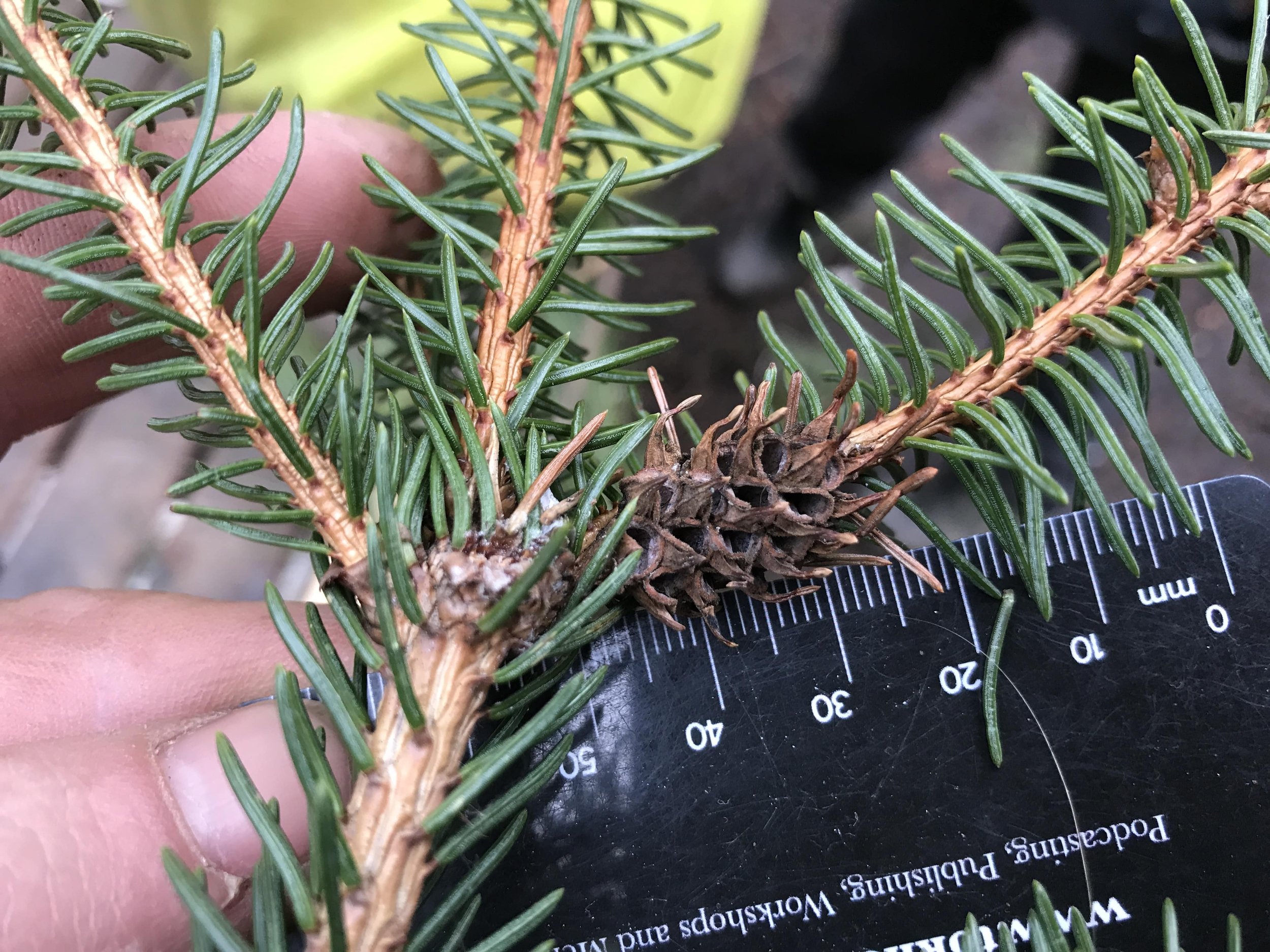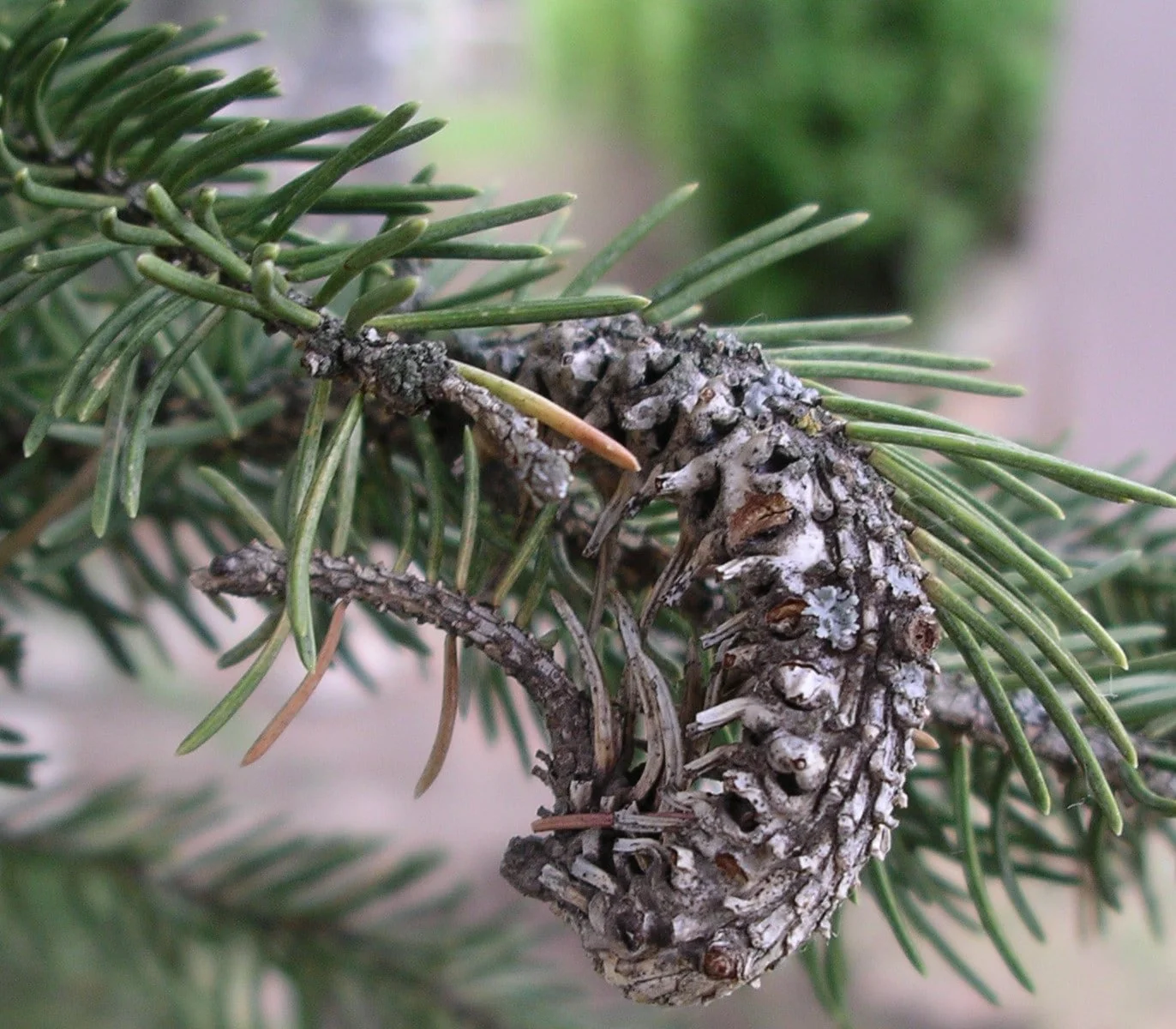Spruce Pineapple Galls
Old gall created by Pineapple Gall Adelgid on White Spruce (Picea glauca), 2024.02.22
White Spruce (Picea glauca)
Needles : not in clusters, but squarish in form
Needle length : 4 - 8 cm
Cone length : 4 -7 cm
Needles four sided, stiff and spirally arranged, similar to a bottle brush. Needles retained from 4 - 7 years.
Buds are sharp pointed up to 2 cm long reddish-brown, resinous with overlapping loose hairy scales.
Bark is scaly.
Seed Cones cylindrical, smooth edged scales, pointed down from the branch.
Notes : Shallow roots make the White Spruce susceptible to windthrow. Wood is light, soft, straight grained, and rots easily.
For a few years I have come across a gall on Spruces all over the Eramosa River Valley. Most of the Spruces are Norway Spruces (Picea abies), but I have also found them on White Spruce (Picea glauca). They were mysterious to me so I looked them up and learned that they were called the Pineapple Spruce Gall, or Spruce Pineapple Gall, or Eastern Spruce Gall depending on who you’re asking. They are created by a small hemipteran (hemiptera : true bugs with piercing-sucking mouthparts) called the Adelges abietis or the Pineapple Gall Adelgid. Adelgids are small insects that are closely related to aphids, a common superfamily of insects who are a little more well known and whom I seem to write and talk about a lot (1)(2)(3)(4).
The gall featured in this post presents in the shape of a Pineapple (Ananas comosus) which has multiple pockets, or cells, each holding a developing larva. It is small, between 15 - 30 mm long found at the base (end closest to the branch) of a small twig. The galls are brown with pale green remnant needles and covered with tiny hairs called trichomes. The needles on which the galls are growing tend to be smaller than the surrounding uninfested needles.
What sets an adelgid and an aphid apart? Well aphids have a tail-like appendage called the cauda which the adelgids do not have. Aphids also have two protruding tube things growing from the posterior end of the dorsal side of their abdomens called cornicles. These cornicles exude sticky quick hardening fluids which the aphids use for defense against predators. Adelgids do not have these either. The adelgids do seem to have similarly amazing life histories, which, for the aphids I have covered before, but in regards to the Adelges abietis species, their life cycles is a little different and has some pretty amazing features.
In Spring, wingless females who were born as clones of their mothers deposit pale yellow eggs in batches of about 50, partly covered with white waxy threads. A short time, in late Spring the nymphs (the offspring of an insect which undergoes incomplete metamorphosis) emerge and begin feeding on the stem at the base of the Spruce needles. This produces a swelling of the needles plant tissues which then develops into the Pineapple Gall we know and love. The galls completely enclose the developing nymphs.
Deformed needles wherein eggs have been laid and larvae will eventually hatch. Photo taken 2022.09.01.
Each gall is made up of a bunch of small chambers, within which are groups of tiny pink-orange nymphs. These nymphs will mature to gallicolae (winged females) which will emerge from the gall in late Summer. These gallicolae may migrate to other Spruce trees or, more commonly, just deposit their new eggs on the same tree. A source I read said that most gallicolae don’t even end up depositing their eggs. Instead, they just die on the Spruce needles they have been feeding on with their eggs still inside them. The eggs will eventually hatch new nymphs which will emerge from their dead mothers bodies and overwinter near the new buds on the Spruce and mature in Spring to new wingless females. And with that, the cycle begins again.
Did you notice something really cool that I am missing above? All these females kicking around, making eggs, giving birth to new females who will then lay more eggs with more females? From what I understand from my research, no males of the species have ever been found. No males! Amazing! I am always thoroughly impressed by nature and all the forms of life and ways of being that can exist. Whoever said that new life requires males and females mating didn’t know about the Spruce Pineapple Adelgids.
A gall made by the Cooley Spruce Gall Adelgid (Adelges cooleyi). Image taken in Cochrane, Alberta. CC 3.0
I have read that the Adelges abietis mostly hang out on the lateral branches when the Spruce trees have more access to Sun, but when there is more shade in the overlaying branches, the Pineapple Spruce Gall Adelgid will start making more galls closer to the top of the trees. I wonder if this is because there is more growth happening in the tree where the Sun is shining, and new growth often means more nutrition going to those particular areas of the trees?
There is another adelgid which makes a gall similar to Adelges abietis, but they are found more commonly found out West. The Cooley Spruce Gall Adelgid (Adelges cooleyi) is rare in the East, including Ontario, but when found, it is often on Colorado Blue Spruce (Picea pungens). I haven’t seen one of their galls yet, but I am on the look out. There are many Blue Spruce in my area so there could be a chance of coming across one.
Adelges, White Spruce, galls… three amazing forms of being in the world which really spark my curiosity, wonder and profound awe for the wilder world around me, reminding me to never stop looking or investigating the unknown strange things I come across in the woods.
To Learn More :
Influential Points entry on Adelges abietis
INTRA- AND INTER-CROWN DISTRIBUTION OF THE EASTERN SPRUCE GALL ADELGID, ADELGES ABIETIS (L.), ON YOUNG WHITE SPRUCE



